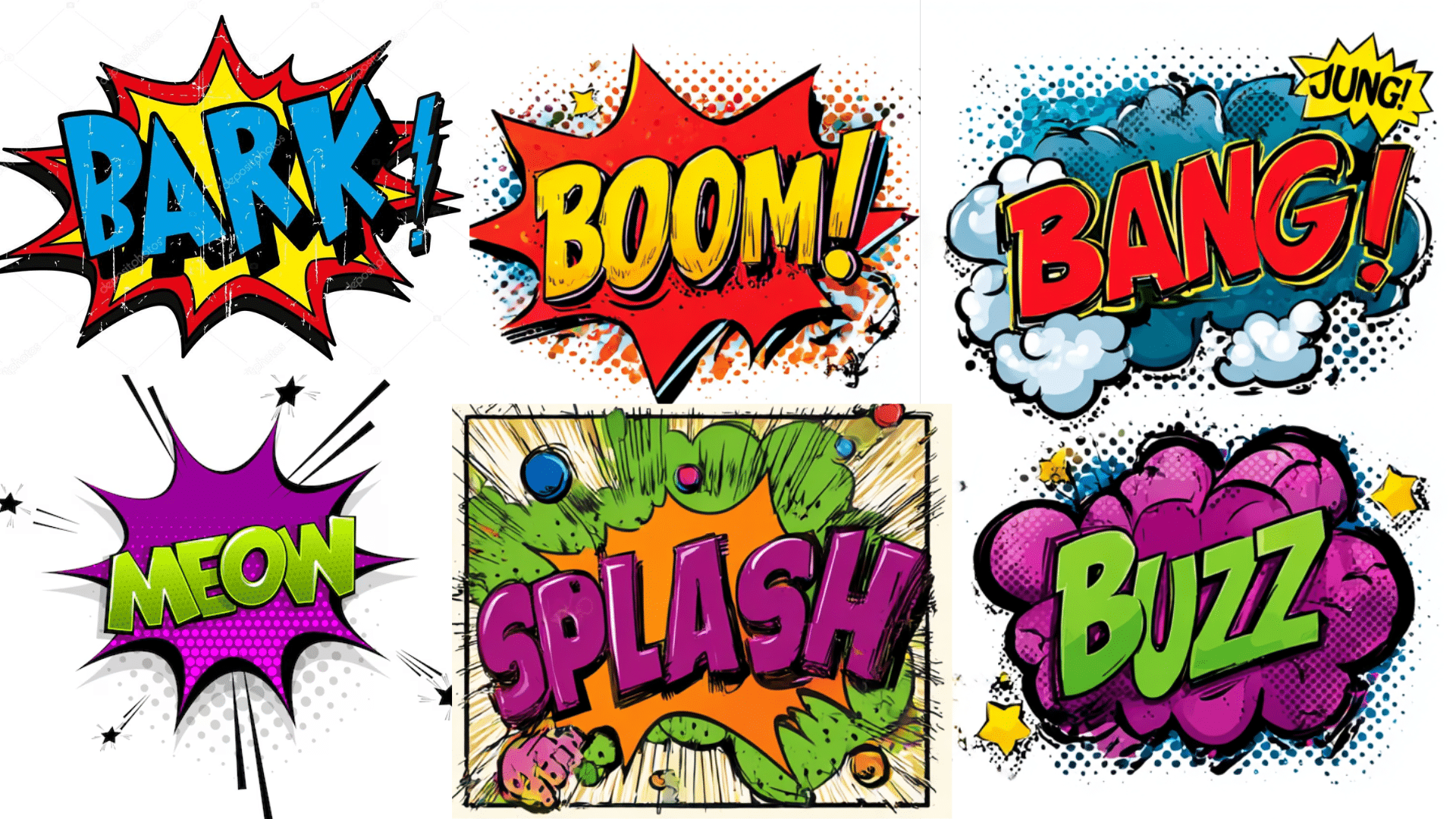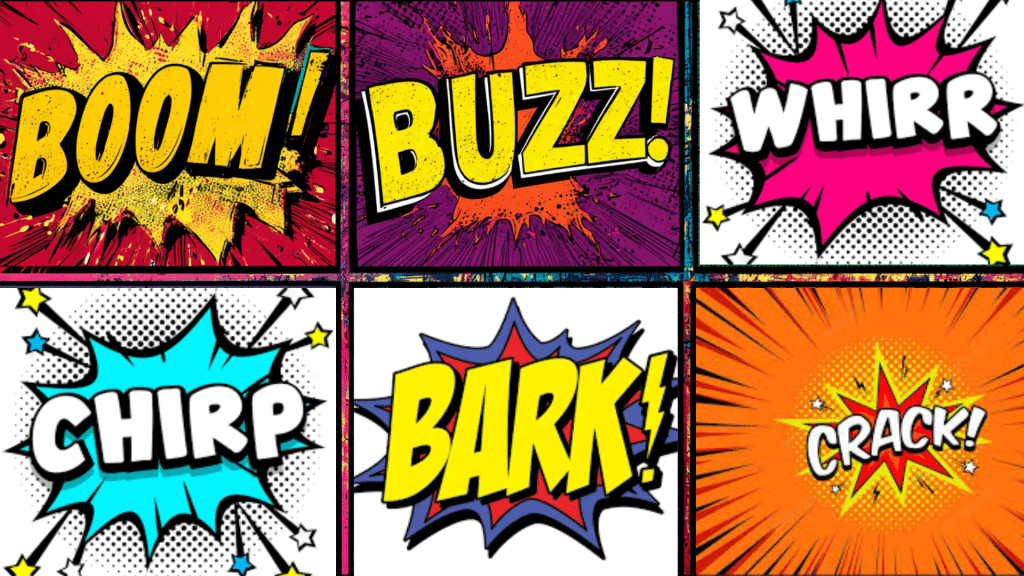I’ve always loved words that sound like the noises they describe. That’s what onomatopoeia is all about.
I’m gonna start explaining what onomatopoeia means and how it’s different from other writing tools. Then I’ll share everyday examples you already know, along with sentences that show the difference it makes.
Take a look at different types of sounds, from animals and nature to machines and people. I’ll also show you how famous authors and poets have used it to create mood and tone.
Let’s get to know about how these sounds change across languages.
What is Onomatopoeia?
Onomatopoeia is a word that copies the sound it describes. It’s when the word itself sounds like the noise you hear in real life. For example, buzz sounds like a bee, and pop sounds like a balloon bursting.
This makes writing more fun and helps readers imagine sounds clearly. Writers often use it in stories, poems, and comics to bring scenes to life.
How It Differs from Other Devices
It’s easy to mix up onomatopoeia with other writing tools. Here’s how they are different:
- Onomatopoeia – Words that sound like the noise (meow, splash, bang).
- Alliteration – Repeating the same starting sound in nearby words (Peter Piper picked a peck).
- Personification – Giving human actions or feelings to non-human things (the wind whispered through the trees).
Onomatopoeia is all about sound. The other two are about style and description.
Common Everyday Onomatopoeia Examples

Onomatopoeia shows up in daily life more than you might think. These simple words copy familiar sounds around us. Below are some of the most common onomatopoeia examples:
- Buzz – the sound of a bee flying.
- Bang – a loud noise, like a door slamming shut.
- Splash – water hitting a surface.
- Drip – drops of water falling slowly.
- Bark – the sound a dog makes.
- Meow – a cat calling out.
- Clang – metal hitting metal.
- Tick-tock – the sound of a clock.
- Boom – an explosion or thunder.
- Chirp – the sound of birds.
- Beep – a car horn or a machine sound.
- Hiss – air or steam escaping.
- Creak – the sound of a door or floorboard moving.
- Woof – another common dog sound.
- Pop – the burst of a balloon or bubble.
- Rustle – leaves moving in the wind.
- Tick – a light, quick clock sound.
- Snap – fingers snapping or something breaking.
- Whirr – a fan or machine spinning.
- Ding – a bell or phone alert.
- Crack – breaking wood or glass.
- Whoosh – fast movement through air.
- Rattle – small objects shaking together.
- Patter – soft steps or falling rain.
- Sizzle – food frying in a pan.
- Clap – hands coming together in applause.
- Groan – a low sound of pain or effort.
- Murmur – soft, unclear talking.
- Whistle – air blown through lips or a device.
- Thud – something heavy hitting the ground.
These everyday examples are easy to recognise. They make writing more vivid because the words carry the sounds inside them.
Types of Onomatopoeia (Organised Lists)
Onomatopoeia can be grouped into categories based on where the sounds come from. This makes it easier to learn and remember.
Animal Sounds
Animals are full of sound words we use in daily life.
- Meow – the sound of a cat.
- Oink – the grunt of a pig.
- Chirp – a small bird calling.
- Roar – the sound of a lion.
- Woof – the bark of a dog.
- Neigh – the call of a horse.
- Quack – the sound of a duck.
- Moo – the call of a cow.
- Baa – the bleat of a sheep.
- Gobble – the sound of a turkey.
- Caw – the harsh call of a crow.
- Hiss – the sound of a snake.
- Cluck – the sound of a chicken.
- Gobble – the sound of a turkey.
- Croak – the sound of a frog.
- Hoot – the call of an owl.
- Buzz – the sound of a bee.
These words help readers imagine animals as if they were right there.
Weather and Nature Sounds
Nature is always making noise, and many words capture those sounds.
- Splash – water hitting a surface.
- Drip – drops of water falling.
- Rumble – thunder in the distance.
- Rustle – leaves moving in the wind.
- Howl – wind blowing strongly.
- Pitter-patter – light rain falling.
- Crash – a wave hitting rocks.
- Whistle – wind moving through gaps.
- Crack – a branch breaking.
- Gush – water flowing quickly.
- Plop – something small falling into water.
- Boom – loud thunder.
- Splashdown – something hitting water heavily.
- Swish – grass or water moving smoothly.
- Swoosh – fast-moving air or water.
These words add atmosphere to stories about the outdoors.
Mechanical and Urban Sounds
Cities and machines also produce sounds that turn into words.
- Beep – the sound of a car or machine.
- Honk – a car horn.
- Clang – metal hitting metal.
- Click – a button or switch.
- Whirr – the hum of a fan or engine.
- Clatter – dishes or objects falling together.
- Bang – a door slamming shut.
- Ding – a bell or elevator alert.
- Toot – a short horn blast.
- Zap – an electric sound.
- Tick – a clock sound.
- Knock – someone rapping on a door.
- Crunch – tires on gravel.
- Grind – gears or machines working.
- Thump – heavy footsteps or machinery noise.
- Crash – a vehicle hitting something.
- Ping – a high-pitched alert or metal strike.
- Clunk – a dull mechanical noise.
- Whack – a solid hit.
- Buzz – electrical humming.
- Whistle – a kettle or train.
- Ring – a phone or alarm.
These sounds bring modern settings to life on the page.
Emotional and Human Sounds
People make many sounds that become words too.
- Giggle – a light laugh.
- Gasp – a sharp intake of breath.
- Hiccup – the sudden noise from a spasm.
- Sigh – a long breath showing relief or sadness.
- Groan – a low sound of pain or complaint.
- Chuckle – a quiet laugh.
- Snore – the sound of sleeping.
- Moan – a drawn-out sound of pain or emotion.
- Sniff – pulling air through the nose.
- Whimper – a soft cry.
- Cry – the sound of tears or wailing.
- Shriek – a high-pitched scream.
- Murmur – soft talking under the breath.
- Yawn – the sound made when tired.
- Laugh – the sound of joy in many forms.
- Shout – a loud voice raised in anger or excitement.
- Scream – a strong, piercing cry.
- Chatter – quick, nonstop talking.
- Snarl – an angry growl-like sound from a person.
- Cough – a sudden noise from the throat.
- Hiss – showing dislike or anger.
- Snicker – a sly, quiet laugh.
- Belch – a loud burp.
- Hum – a steady tune from the mouth.
- Roar – a loud cry or cheer from people.
- Sniff – pulling air through the nose.
These words show emotion in a natural way that feels real.
Using Onomatopoeia in a Sentence
It’s easier to understand onomatopoeia when you see it in use. These examples show how adding sound words makes writing feel more real.
| Without Onomatopoeia | With Onomatopoeia |
|---|---|
| The cat sat on the fence. | The cat sat on the fence and meowed. |
| The kids ran through the puddles. | The kids ran through the puddles with a loud splash. |
| The door opened slowly. | The door opened slowly with a creak. |
| The balloon burst suddenly. | The balloon went pop as it burst. |
| The thunder was loud. | The thunder went boom across the sky. |
By using onomatopoeia, you turn plain sentences into ones that readers can hear in their heads.
Onomatopoeia in Literature and Poetry
Writers often use onomatopoeia to make their work more alive. These sound words help readers hear what’s happening, not just see it.
Famous Examples
- Edgar Allan Poe’s The Bells – Words like tinkle and clang echo the ringing of different bells.
- Lewis Carroll’s Jabberwocky – Words like snicker-snack create playful, made-up sounds.
- Children’s poems and rhymes – Phrases like ding-dong or cock-a-doodle-doo keep young readers engaged.
Why Authors Use It
- Tone – Adds playfulness, fear, or excitement.
- Mood – Creates the right feeling, like calm rain with pitter–patter.
- Immersion – Pulls readers into the scene as if they are hearing it themselves.
Onomatopoeia in poems and stories is more than decoration. It’s a tool that shapes how the reader feels and experiences the moment.
Onomatopoeia Across Languages
Onomatopoeia is not the same everywhere. Different cultures hear and write sounds in their own way. What sounds like woof in English might sound completely different in another language.
- Dog – woof (English), wan-wan (Japanese), guau-guau (Spanish).
- Rooster – cock-a-doodle-doo (English), kikiriki (Spanish), ko-ke-kok-ko-o (Japanese).
- Cat – meow (English), miau (Spanish), nyan (Japanese).
- Duck – quack (English), coin-coin (French), ga-ga (Chinese).
- Pig – oink (English), grunz (German), boo-boo (Japanese).
These differences show how sound is shaped by language and culture. The real-world noise is the same, but people describe it in ways that fit their own speech.
Conclusion
Onomatopoeia is more than just fun sound words. It’s a way to make writing feel alive and full of energy.
From everyday noises like buzz and splash to the powerful boom of thunder, these words help readers hear the world through text.
Authors and poets use them to set tone and mood, while teachers use them to make lessons interactive and exciting.
Even across languages, these sounds remind us how people everywhere describe the world around them.
Now that you’ve seen the meaning, examples, and uses, try adding onomatopoeia to your own stories or lessons. It’s simple, creative, and memorable. Start using it today!











